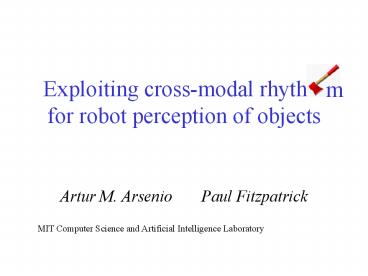Exploiting cross-modal rhythm for robot perception of objects PowerPoint PPT Presentation
Title: Exploiting cross-modal rhythm for robot perception of objects
1
Exploiting cross-modal rhythm for robot
perception of objects
- Artur M. Arsenio Paul Fitzpatrick
MIT Computer Science and Artificial Intelligence
Laboratory
2
Cog the humanoid platform
cameras on active vision head
microphone array above torso
periodically moving object (hammer)
periodically generated sound (banging)
3
Motivation
- Tools are often used in a manner that is composed
of some repeated motion - consider hammers, saws,
brushes, files, - Rhythmic information across the visual and
acoustic sensory modalities have complementary
properties - Features extracted from visual and acoustic
processing are what is needed to build an object
recognition system
4
Interacting with the robot
5
Talk outline
- Matching sound and vision
- Matching with visual distraction
- Matching with acoustic distraction
- Matching multiple sources
- Priming sound detection using vision
- Towards object recognition
6
Detecting periodic events
- Tools are often used in a manner that is composed
of some repeated motion - consider hammers, saws,
brushes, files. - Points tracked using Lukas-Kanade algorithm
- Periodicity Analysis
- FFTs of tracked trajectories
- Periodicity Histograms
- Phase verification
7
Matching sound and vision
8
6
4
frequency (kHz)
2
0
0
500
1000
1500
2000
1500
1000
energy
500
0
0
500
1000
1500
2000
2500
-50
- The sound intensity peaks once per visual period
of the hammer
-60
hammer position
-70
-80
0
500
1000
1500
2000
2500
time (ms)
8
Matching with visual distraction
- One object (the car) making noise
- Another object (the ball) in view
- Problem which object goes with the sound?
- Solution Match periods of motion and sound
9
Comparing periods
- The sound intensity peaks twice per visual period
of the car
10
Matching with acoustic distraction
Matching with acoustic distraction
11
Matching multiple sources
- Two objects making sounds with distinct spectrums
- Problem which object goes with which sound?
- Solution Match periods of motion and sound
12
Binding periodicity features
- The sound intensity peaks twice per visual period
of the car. For the cube rattle, the sound/visual
signals have different ratios according to the
frequency bands
13
Statistics
An evaluation of cross-modal binding for various
objects and situations
the sound generated by a periodically moving
object can be much more complex and ambiguous
than its visual trajectory
14
Priming sound detection using vision
Signals in Phase
15
Signals out of phase!
16
Object recognition
- Visual object segmentation
- Cross-modal object recognition
- Ratio between acoustic/visual fundamental
frequencies - Phase between acoustic and visual signals
- Range of acoustic frequency bands
17
Cross-modal object recognition
Causes sound when changing direction, often quiet
during remainder of trajectory (although bells
vary)
Causes sound when changing direction after
striking object quiet when changing direction to
strike again
Causes sound while moving rapidly with wheels
spinning quiet when changing direction
18
Clustering
19
Conclusions
- Different objects distinct acoustic-visual
patterns which are a rich source of information
for object recognition. Object differentiation
from both its visual and acoustic backgrounds by
binding pixels and frequency bands that are
oscillating together - Cognitive evidence that, for humans, simple
visual periodicity can aid the detection of
acoustic periodicity - More feature can be used for better
discrimination, like the ratio of the
sound/visual peak amplitudes - Each type of features are important for
recognition when the other is absent. But when
both are present, then we can do better by
looking at the relationship between visual motion
and the sound generated.
20
Questions?
Questions?

